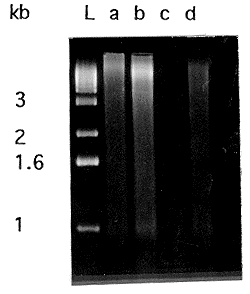A safe method of extracting DNA from Coccidioides immitis
Austin Burt(1), Deidre A. Carter(2), Gina L. Koenig(2), Thomas J. White(2) and John W. Taylor(1)
(1)Department of Plant Biology, University of California, Berkeley CA 94720, and (2)Roche
Molecular Systems, 1145 Atlantic Ave., Alameda CA 94501.
Human-pathogenic fungi such as Coccidioides immitis and Histoplasma capsulatum must
be handled in Biosafety level 3 containment facilities which make for a very awkward
working environment (J.Y. Richmond and R.W. McKinney, eds. Biosafety in Microbiological
and Biomedical Laboratories, 3rd ed. NIH, Washington). In this paper we describe a safe
and convenient method of extracting DNA from such fungi in which the culture is killed by
steaming, allowing removal from the containment facilities, as soon as possible. The method
was first developed with the non-pathogen Neurospora crassa, has worked well for both C.
immitis and H. capsulatum, and should be useful for extracting DNA from any pathogenic
fungus.
Cultures of C. immitis are grown in the saprophytic phase at 37 C in 100 ml of 2X GYE
medium (20 g glucose and 10 g yeast extract in 1 liter medium, autoclaved for 15 min.) in
500 ml plastic Nalgene flasks with plastic foam stoppers (Identi-plug, Fisher). When there
has been sufficient growth, the whole container is transferred to an autoclave and steamed
at 1 atm (100 C) for 15 min. This raises the temperature of the culture to about 95 C (as
measured in trials with a thermocouple). The culture is allowed to cool, 1 ml is plated on
2X GYE or potato dextrose agar, and the rest frozen at -20 C. If there is no growth on the
plate after 1 week, the culture is assumed to be dead and is removed from the containment
room to proceed with the DNA extraction.
Cultures are thawed, filtered, frozen in liquid nitrogen, lyophilized, and ground with a
mortar and pestle. About 10 mg of dry ground tissue is mixed with 400 ul lysis buffer (50
mM Tris, 100 uM NaCl, 5 mM EDTA, 1% sodium dodecyl sulfate), and incubated at 80 C
for 10 min., cooled to 40 C and incubated with 10 ul of 10 mg/ml Proteinase K for 2-3h,
and then incubated again at 80 C for 10 min. The DNA is then extracted with chloroform-
phenol and precipitated with isopropanol, following Lee and Taylor (In: M. A. Innis et al,
eds. PCR Protocols, pp. 282-287, Academic Press, San Diego). The pellet is resuspended in
100 ul TE, and 5 ul of this is electrophoresed in agarose to check the yield - usually there
is an easily visible band of high molecular weight DNA (Figure 1). We have successfully
amplified the DNA by PCR and sequenced the product directly.
The main innovation of this protocol is the use of steam to kill the culture. By doing this
at an early stage, right in the culture flask, exposure to the fungus is minimized. In trials
with Neurospora crassa, steaming at 1 atm gave a much higher yield of DNA than
autoclaving under pressure. The addition of Proteinase K to the lysis buffer also increases
yield (Figure 1), presumably by digesting away proteins which are bound to the DNA and
denatured by the heat.
Acknowledgements: Norman Pace suggested the lysis buffer recipe and the use of Proteinase
K. Financial support came from NIH-NIAID grant AI28545.

Figure 1. Genomic DNA extracted from 10 mg lyophilized C. immitis after killing with steam.
a, b: strain 1; c, d: strain 2; a, c: without Proteinase K; b, d: with Proteinase K; L: 1 kb DNA
size ladder (Gibco BRL). Gel was treated with RNAse after electrophoresis.
